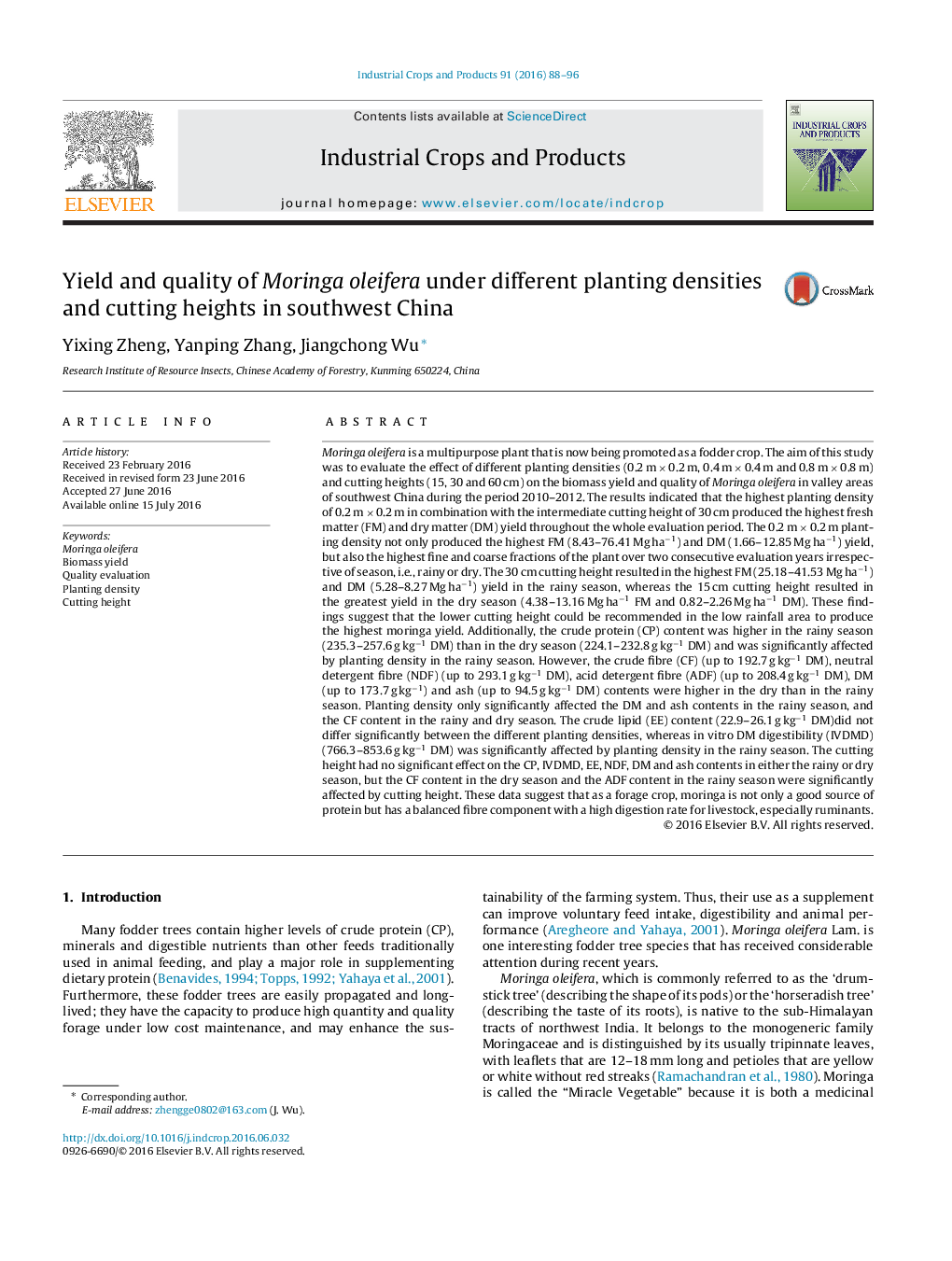| کد مقاله | کد نشریه | سال انتشار | مقاله انگلیسی | نسخه تمام متن |
|---|---|---|---|---|
| 4511984 | 1624819 | 2016 | 9 صفحه PDF | دانلود رایگان |
• Moringa has the higher capacity to produce fresh biomass and dry biomass.
• Moringa was rich in crude protein and in vitro dry matter digestibility.
• Moringa can sustain and improve farmers’ livestock systems.
Moringa oleifera is a multipurpose plant that is now being promoted as a fodder crop. The aim of this study was to evaluate the effect of different planting densities (0.2 m × 0.2 m, 0.4 m × 0.4 m and 0.8 m × 0.8 m) and cutting heights (15, 30 and 60 cm) on the biomass yield and quality of Moringa oleifera in valley areas of southwest China during the period 2010–2012. The results indicated that the highest planting density of 0.2 m × 0.2 m in combination with the intermediate cutting height of 30 cm produced the highest fresh matter (FM) and dry matter (DM) yield throughout the whole evaluation period. The 0.2 m × 0.2 m planting density not only produced the highest FM (8.43–76.41 Mg ha−1) and DM (1.66–12.85 Mg ha−1) yield, but also the highest fine and coarse fractions of the plant over two consecutive evaluation years irrespective of season, i.e., rainy or dry. The 30 cm cutting height resulted in the highest FM (25.18–41.53 Mg ha−1) and DM (5.28–8.27 Mg ha−1) yield in the rainy season, whereas the 15 cm cutting height resulted in the greatest yield in the dry season (4.38–13.16 Mg ha−1 FM and 0.82–2.26 Mg ha−1 DM). These findings suggest that the lower cutting height could be recommended in the low rainfall area to produce the highest moringa yield. Additionally, the crude protein (CP) content was higher in the rainy season (235.3–257.6 g kg−1 DM) than in the dry season (224.1–232.8 g kg−1 DM) and was significantly affected by planting density in the rainy season. However, the crude fibre (CF) (up to 192.7 g kg−1 DM), neutral detergent fibre (NDF) (up to 293.1 g kg−1 DM), acid detergent fibre (ADF) (up to 208.4 g kg−1 DM), DM (up to 173.7 g kg−1) and ash (up to 94.5 g kg−1 DM) contents were higher in the dry than in the rainy season. Planting density only significantly affected the DM and ash contents in the rainy season, and the CF content in the rainy and dry season. The crude lipid (EE) content (22.9–26.1 g kg−1 DM)did not differ significantly between the different planting densities, whereas in vitro DM digestibility (IVDMD) (766.3–853.6 g kg−1 DM) was significantly affected by planting density in the rainy season. The cutting height had no significant effect on the CP, IVDMD, EE, NDF, DM and ash contents in either the rainy or dry season, but the CF content in the dry season and the ADF content in the rainy season were significantly affected by cutting height. These data suggest that as a forage crop, moringa is not only a good source of protein but has a balanced fibre component with a high digestion rate for livestock, especially ruminants.
Journal: Industrial Crops and Products - Volume 91, 30 November 2016, Pages 88–96
